| کد مقاله | کد نشریه | سال انتشار | مقاله انگلیسی | نسخه تمام متن |
|---|---|---|---|---|
| 39295 | 45817 | 2015 | 9 صفحه PDF | دانلود رایگان |
• Unsupported Ni–Mo–S catalysts were prepared by hydrothermal method.
• Deoxgenation degree reached to 99.8% at 300 °C and 4.0 MPa H2 pressure for 6 h.
• Both the conversion and HYD route were enhanced with the increase of hydrogen pressure.
• Synergistic effect could be explained by RC model through a migration of hydrogen spillover.
• An optimal balance between NiS2 and MoS2 leads to the maximum HDO activity of Ni–Mo–S.
Unsupported Ni–Mo–S catalysts with different Ni/(Ni + Mo) molar ratio were prepared by hydrothermal method using ammonium heptamolybdate and thiocarbamide as materials. The resultant catalysts were characterized by X-ray diffraction, nitrogen physisorption and transmission electron microscopy, and their activities were measured using the hydrodeoxygenation (HDO) of p-cresol as a probe reaction. The addition of Ni promoter caused a reduction in the surface area. The peaks attributed to NiS2 on catalyst surface became noticeable as the Ni content increased in the catalyst. The catalyst with an optimal Ni/(Ni + Mo) molar ratio (0.3) exhibited the highest activity (99.8% deoxgenation degree at 300 °C and 4.0 MPa hydrogen pressure for 6 h). The HDO of p-cresol on these prepared Ni–Mo–S catalysts proceeded with two parallel routes: hydrogenation-dehydration (HYD) and direct deoxygenation (DDO), and HYD/DDO closely related to the Ni/(Ni + Mo) molar ratio in the catalyst, the HDO reaction temperature and H2 pressure. The comparison of Ni–Mo–S with MoS2–NiS2 (prepared by two hydrothermal method) and MoS2 + NiS2 (prepared by physically mixing separately MoS2 and NiS2) indicated that the high HDO activity of Ni promoted MoS2 catalyst was attributed to the synergistic effect of MoS2 and NiS2 rather than the formation of Ni–Mo–S phase, which could be well explained by the remote control model.
Figure optionsDownload high-quality image (101 K)Download as PowerPoint slide
Journal: Applied Catalysis A: General - Volume 495, 5 April 2015, Pages 8–16
